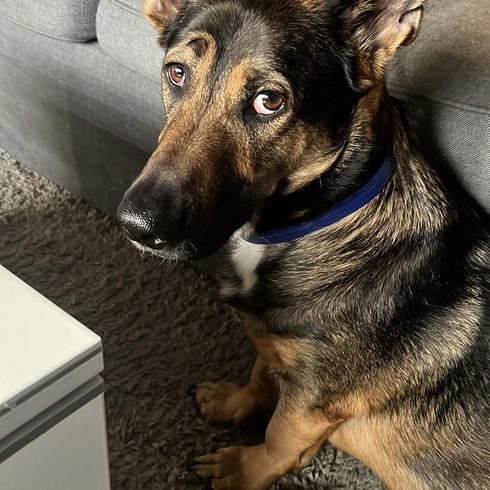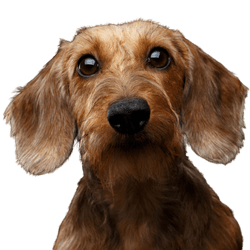Facts & Origin
Dachshund and German Shepherd mixed breeds: a fusion of hunting and herding instincts.
The history of the Dachshund and the German Shepherd is deeply rooted in dog breed history. Both dogs have a rich past that comes together in a hybrid of these two breeds. The Dachshund, also known as the Badger Dog in other parts of the world, has its roots in medieval Germany. He was originally bred to hunt badgers and other small animals. His long, low stature allowed him to venture into badger burrows and pull out his prey. Over the centuries, the breed was adapted in different regions and bred in different sizes and coat types, but the original hunting instinct remained.
The German Shepherd, on the other hand, comes from a completely different corner of the working dog spectrum. Developed in Germany in the late 19th and early 20th centuries, this dog was bred as an all-purpose working dog, with special emphasis on herding and guarding functions. Its intelligence, trainability and loyalty were quickly recognized, leading to its worldwide popularity as one of the best working dogs.
Thus, the combination of these two breeds in a mongrel combines the Dachshund's deep history as a hunter and the German Shepherd's many functions as a herding and guard dog. Such a mongrel embodies an exciting fusion of instincts, skills, and histories that is rare in the canine world. It is fascinating to see how the ancient histories and traditions of these two iconic German breeds can blend into a single animal.




| Alternate Name | Dachshund german shepherd mongrel |
| Origin | Germany |
| Life expectancy | 9 - 16 years |
| Care requirements | low-maintenance |
| Activity level | average - high |
| FCI group | not recognised |
| AKC group | not recognised |
| KC group | not recognised |
More Dachshund mixes
More German Shepherd mixes
Attitude, character and temperament of the breed
Character and nature of Dachshund-Shepherd-Mixes
A Dachshund-Sheepdog mix is an impressive fusion of the characteristic traits of its parent breeds. However, the temperament of these mixed breed dogs can vary depending on which traits they inherit from which parent.
Character: Many Dachshund-Sheepdog mixes tend to have the courage and tenacity of the Dachshund, combined with the intelligence and loyalty of the German Shepherd. These dogs can prove to be very alert and often have a strong protective instinct. However, they retain the curiosity and playfulness that is characteristic of the Dachshund.
Temperament: Mixed breeds of these two breeds tend to be affectionate and loving towards their family, but they can also be a bit independent or stubborn, especially if the Dachshund influence is strong. Their intelligence also means they are easily trainable, but at the same time they need consistent training as they can sometimes try to get the upper hand.
Attitude:
Exercise: Both parent breeds are active and need regular exercise. A daily walk or playtime in the yard may be necessary to keep them mentally and physically occupied.
Training: early socialization and consistent training are essential to ensure the mixed breed is well adjusted and obedient. Their intelligence means they learn quickly, but it can also mean they get bored easily. Varied training can help keep them engaged and motivated.
Living situation: although they can adapt to a variety of living conditions, these mixed breeds are best suited to a home with a fenced yard where they can play safely. Their size and energy can be problematic in a smaller home if they don't get enough exercise.
Character



Dachshund and German Shepherd Mixed Breed Health and Care.
Mixing two breeds as different as the Dachshund and the German Shepherd can present both health and care benefits and challenges.
Health: mixed breed dogs tend to have better genetic diversity, which can protect them from some of the specific health issues that affect pure breeds. Still, Dachshund-Sheepdog mixes could be susceptible to health problems that are common in both breeds.
Dachshund-related health problems: Because of their long spine, Dachshunds are prone to back problems, especially herniated discs.
German Shepherd-related health problems: This breed can be prone to hip dysplasia and other joint problems.
It is important to schedule regular vet visits and watch for signs of discomfort or pain.
Grooming: Coatgrooming depends on the type of coat inherited. A shorter coat may require less grooming than a long, dense coat. Regular brushing can help keep the coat clean and free of tangles and promote skin health.
Potential Breeding and Concerns: Selective breeding of mixed breed dogs, especially those with such different body structures as the Dachshund and German Shepherd, is not usually recommended. Here are some reasons:
- Unpredictable physical results: The huge size and structural differences between these two breeds can lead to health problems in the puppies, especially if the Dachshund is the mother.
- Health risks: The risk of genetic health problems associated with both breeds cannot be overlooked. A puppy could be susceptible to the health problems of both breeds.
- Ethics: there are many dogs already waiting for loving homes. Purposeful mixed-breed breeding without a clear purpose can be considered unethical, especially if it is just for aesthetic preference or fad.


Dachshund-Shepherd-Mixed Breed Optics
The appearance of a Dachshund German Shepherd mix can vary greatly, as the two parent breeds are physically very different. Depending on which genetic traits dominate, mixed breeds of these breeds can have a range of physical characteristics. It is important to note that no two mixed breeds will look exactly alike, but here are some general characteristics that may occur:
- Size: they will likely be of an average size, somewhere between that of a Dachshund and a German Shepherd. Some may be closer to the size of a Dachshund, while others may be larger and more robust like a German Shepherd.
- Coat: Coat length and texture can vary. Some mixed breeds might inherit the short, smooth coat of a Dachshund, while others might have the denser, longer coat of a German Shepherd. There is also the possibility of variations between these extremes. Color can range from black and brown, as in many German Shepherds, to the various colors and patterns common in Dachshunds.
- Face: the muzzle could be longer than that of a typical Dachshund, but not as pronounced as a German Shepherd. The eyes may have an almond shaped structure like the German Shepherd or a rounder shape like the Dachshund.
- Ears: This can be an interesting mix. While Dachshunds typically have drooping ears, German Shepherds ears are erect. So the mixed breed could have either drooping, semi-erect or erect ears.
- Build: the body could be longer, similar to that of a Dachshund, but sturdier and stronger, similar to that of a German Shepherd. The legs could be shorter than a German Shepherd, but longer than a Dachshund.
| Fur length | short - long |
| Fur | rough-haired - flat coated |
| Ear shape | Floppy Ear - Standing Ears |
| Tail | short - fanned out |
| Anatomy | strong, massive, strong |
| Size ♀ | 17 - 60 cm |
| Weight ♀ | 7 - 32 kg |
| Size ♂ | 17 - 65 cm |
| Weight ♂ | 7 - 40 kg |
| Suitable For | - |



Known Diseases
Dachshund Paralysis
By dachshund paralysis (discopathy) veterinarians mean paralysis of the limbs in dogs.
Overweight
Often, unfortunately, the dogs very much under excess weight. But the dogs themselves are never to blame!
Disc problems
Herniated disc in dogs (discopathy). Herniated discs or dachshund paralysis cause dogs severe pain.




















